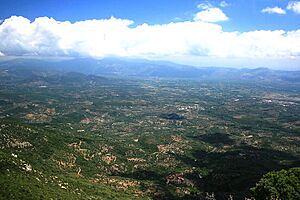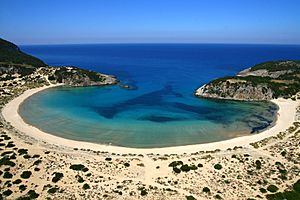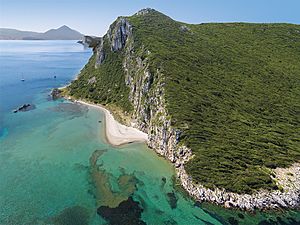Messenia facts for kids
Quick facts for kids
Messenia
Περιφερειακή ενότητα
Μεσσηνίας |
|
|---|---|
|
Regional unit
|
|

Municipalities (dimi) of Messenia, 2010:
|
|

Messenia within Greece
|
|
| Country | Greece |
| Region | Peloponnese |
| Capital | Kalamata |
| Area | |
| • Total | 2,991 km2 (1,155 sq mi) |
| Population
(2011)
|
|
| • Total | 159,954 |
| • Density | 53.478/km2 (138.509/sq mi) |
| Time zone | UTC+2 (EET) |
| • Summer (DST) | UTC+3 (EEST) |
| Postal codes |
24x xx
|
| Area codes | 272x0, 276x0 |
| ISO 3166 code | GR-17 |
| Car plates | ΚΜ |


Messenia or Messinia is a region in the southwestern part of Greece. It is located in the Peloponnese area. Since 2011, Messenia has been known as a "regional unit." Its capital and largest city is Kalamata.
Contents
Exploring Messenia's Landscape
Land and Water Features
Messenia shares borders with other regions of Greece. To the north is Elis, to the northeast is Arcadia, and to the southeast is Laconia. The Ionian Sea is to the west, and the Gulf of Messinia is to the south.
The region has important mountain ranges. These include the Taygetus in the east and the Kyparissia mountains in the northwest. The main rivers are the Neda in the north and the Pamisos in the center.
Islands and Climate
Off the southwestern coast of Messenia are the Messinian Oinousses islands. The largest islands are Sapientza, Schiza, and Venetiko. The small island of Sphacteria is located near the bay of Pylos. Most of these islands have very few people living on them.
The weather in Messenia can change. In the lower areas, it is a bit warmer than in Athens. Snow is not common in winter, except in the mountains like Taygetus. Rain and clouds are often seen inland.
How Messenia is Organized
Messenia is divided into six main areas called municipalities. These are:
- Kalamata
- Mani
- Messini
- Oichalia
- Pylos-Nestoras
- Trifylia
Before 2010, Messenia was called a "prefecture" and had many smaller local governments. Now, it is a "regional unit" with fewer, larger municipalities. This change helped organize the region better, but the total area and population stayed the same.
People and Cities
Population Changes Over Time
The number of people living in Messenia has changed over the years:
- 1991: 167,292 people
- 2001: 172,875 people
- 2011: 159,954 people
Major Towns and Cities
Here are the main cities and towns in Messenia, based on how many people lived there in 2011:
- Kalamata: 54,567 people
- Filiatra: 6,791 people
- Messini: 6,287 people
- Kyparissia: 5,784 people
- Gargalianoi: 5,569 people
- Chora (Nestoras): 3,498 people
- Pylos: 2,767 people
Messenia's Economy
Messenia's economy mainly relies on farming. However, in recent years, the region has also been working to grow its tourism industry.
Farm Products and Food
The main farm products from Messenia are:
- Olive oil
- Kalamata table olives
- Figs
- Black raisins (sultanas)
Farmers also raise some animals for meat, milk, and honey. Fish from the Gulf of Messenia is also an important part of the local food.
Tourism and Development
Tourism has grown because of important historical places. These include the Palace of Nestor and Ancient Messene. There are also old castles built by the Venetians in Pylos, Koroni, Methoni, and Kalamata. The beautiful natural scenery also attracts visitors.
A big part of Messenia's economy is Costa Navarino. This area has luxury resorts and golf courses. It is one of Greece's largest tourism projects.
Local Businesses
Many small and medium-sized businesses in Messenia process farm products. Other companies work with wood, make furniture, or build metal structures. The Karelia tobacco company is also located in Kalamata.
Getting Around Messenia
Air Travel
The main airport in Messenia is Kalamata International Airport (KLX).
Roads
Major highways in Messenia connect it to other parts of Greece:
- Greek National Road 7 connects to Corinth and Tripoli.
- Greek National Road 9 connects to Patras and Pyrgos.
- Greek National Road 82 connects Pylos to Kalamata and Sparti.
Railways
Messenia also has railway lines:
- One line goes from Corinth to Kalamata.
- Another line connects Patras to Kyparissia.
- A third line links Kalo Nero to Zevgolateio.
Staying Connected: Television
People in Messenia can watch local television channels, including:
- Notia Elliniki Teleorasi (Southern Greece Television)
- Best TV
- Mesogeios TV
A Look at Messenia's Past
Ancient Times
Messenia is mentioned in the Iliad, a very old Greek story. The name of the region likely comes from the Bronze Age. In ancient times, Messenia was conquered by ancient Sparta. Many of its people were forced to become helots, which were like slaves.
Medieval History
During the Middle Ages, Messenia's history was similar to the rest of the Peloponnese. You can still see old castles from this time in Kalamata, Koroni, Methoni, and Pylos. Messenia was part of the Byzantine Empire until 1205. After that, it became part of the Principality of Achaea. The important ports of Koroni and Methoni were controlled by the Venetians. By 1430, most of Messenia was taken over by the Byzantine Despotate of the Morea.
Ottoman and Venetian Rule
In 1460, much of Messenia fell under the rule of the Ottoman Empire. Some parts stayed with Venice until the early 1500s. In the 1680s, Venice took back all of Messenia during a war. It was called the "Kingdom of the Morea" under Venetian rule. But in 1715, the Ottomans took it back again. The Mani Peninsula, which is part of modern Messenia, managed to stay independent from Turkish rule.
Modern Era
Messenia became part of independent Greece after the Greek War of Independence (1821-1832). A very important naval battle, the Battle of Navarino, happened near Pylos in 1827. This battle was a big win for Greece and its allies.
During World War II, many battles took place in Messenia. Greek resistance fighters fought against the Nazi forces. Some of these battles include the Battle of Meligalas and the Battle of Kalamata.
The population in the Kalamata and Messene areas grew a lot after World War II. In 2007, Messenia was affected by large 2007 Greek forest fires.
See also
 In Spanish: Mesenia para niños
In Spanish: Mesenia para niños
- List of settlements in Messenia
- Messenia (constituency)






